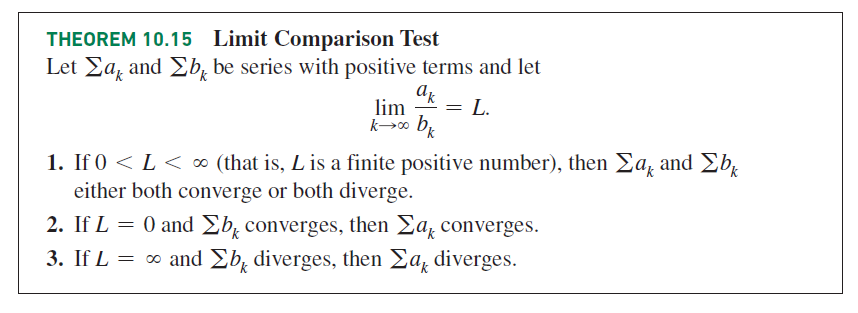THEOREM 10.15 Limit Comparison Test Let Ea, and Eb, be series with positive terms and let lim L. 1. If 0 < L < ∞ (that is, L is a finite positive number), then Ea, and Eb, either both converge or both diverge. 2. If L = 0 and Eb, converges, then Ea, converges. 3. If L = ∞ and Eb, diverges, then Ea, diverges.
THEOREM 10.15 Limit Comparison Test Let Ea, and Eb, be series with positive terms and let lim L. 1. If 0 < L < ∞ (that is, L is a finite positive number), then Ea, and Eb, either both converge or both diverge. 2. If L = 0 and Eb, converges, then Ea, converges. 3. If L = ∞ and Eb, diverges, then Ea, diverges.
Algebra & Trigonometry with Analytic Geometry
13th Edition
ISBN:9781133382119
Author:Swokowski
Publisher:Swokowski
Chapter10: Sequences, Series, And Probability
Section10.2: Arithmetic Sequences
Problem 67E
Related questions
Question
Explain how the Limit Comparison Test works.

Transcribed Image Text:THEOREM 10.15 Limit Comparison Test
Let Ea, and Eb, be series with positive terms and let
lim
L.
1. If 0 < L < ∞ (that is, L is a finite positive number), then Ea, and Eb,
either both converge or both diverge.
2. If L = 0 and Eb, converges, then Ea, converges.
3. If L = ∞ and Eb, diverges, then Ea, diverges.
Expert Solution
Step 1
Let and be two positive term series, and .
1. If (i.e. L is a finite positive number) Then and both converge or diverge together.
2. If and converges, then also converges.
3. and diverges, then also diverges.
Step 2
1. Since ,
But
Now
given , a positive integer m such that
Choose such that .
Let where
Case-1: When is convergent
From
Since is convergent, is also convergent.
Case.II: When is divergent.
From ,
Since is divergent, is also divergent.
Case.III: When is convergent.
From (*),
Since is convergent, is also convergent.
Case:IV: When is divergent.
From (*),
Since is divergent, is also divergent.
Hence and converge or diverge together.
Step by step
Solved in 4 steps

Knowledge Booster
Learn more about
Need a deep-dive on the concept behind this application? Look no further. Learn more about this topic, advanced-math and related others by exploring similar questions and additional content below.Recommended textbooks for you

Algebra & Trigonometry with Analytic Geometry
Algebra
ISBN:
9781133382119
Author:
Swokowski
Publisher:
Cengage

Algebra & Trigonometry with Analytic Geometry
Algebra
ISBN:
9781133382119
Author:
Swokowski
Publisher:
Cengage